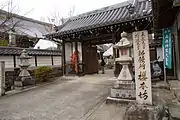

A shukubo (宿坊) is a temple lodging in Japan that allows visitors to stay overnight within a Buddhist temple.[1] Originally, these facilities were designed to accommodate only monks and worshippers, but nowadays, in response to declining numbers of monk visitors, most facilities accept general tourists.[2] Some temples, such as Mount Kōya, have open-air baths with onsen.[3] Shukubo are now considered semi-secularized and in many towns are the only accommodations available.[3]
History
Originally, shukubo were used by bhikku and confraternities,[2] and later by lay practitioners of Shugendō and mountain worship, and played major roles in the development of the latter two.[4] At the foot of Mount Haguro there were once 336 shukubo all linked to Shugendō.[5]
Networks of shukubo began to develop in Ise, Shima, Toba, and Futami-ura in a decades long construction boom.[6]
In the Edo period, visits to temples and shrines became popular, including visits to Ise, Kotohira-gū, and Zenkō-ji. Lodging houses were built at major temples and shrines in each area to accommodate ordinary pilgrims and tourists, forming a kind of tourism business, with specific areas connected to specific lodging houses.[3]
In modern times, some shukubo have been converted into traditional inns and ryokan for tourists who want to experience the atmosphere of a temple.[7] Many modern-day operators of shukobo are descendants of families that ran shukubo when they were a purely religious matter. Originally, they only operated for one kosha but opening to the general public has substantially increased amounts of people staying at shukubo.[2]
Gallery
 Sakuramotobō
Sakuramotobō Shōjin ryōri at Hagurosan Saikan
Shōjin ryōri at Hagurosan Saikan Hagurosan Saikan Room
Hagurosan Saikan Room Inside the Hagurosan Saikan lodging house (corridor and rooms)
Inside the Hagurosan Saikan lodging house (corridor and rooms)
See also
References
- ↑ Earhart, H. Byron (1968). "The Celebration of "Haru-Yama" (Spring Mountain): An Example of Folk Religious Practices in Contemporary Japan". Asian Folklore Studies. 27 (1): 1–24. doi:10.2307/1177798. JSTOR 1177798.
- 1 2 3 Carter, C. (2018). "Power Spots and the Charged Landscape of Shinto". Japanese Journal of Religious Studies. 45 (1): 145–174. doi:10.18874/jjrs.45.1.2018.145-173. JSTOR 26854474. S2CID 165172176.
- 1 2 3 Reader, Ian (2020). "Turning to Tourism in a Time of Crisis?: Buddhist Temples and Pilgrimage Promotion in Secular(ized) Japan". In Bruntz, Courtney; Schedneck, Brooke (eds.). Buddhist Tourism in Asia. University of Hawai’i Press. pp. 161–80. doi:10.2307/j.ctvgs09c4.13. S2CID 216255881.
- ↑ Kaminishi, I. (2006). "Deciphering Mountain Worship". Explaining Pictures: Buddhist Propaganda and Etoki Storytelling in Japan. University of Hawai’i Press. pp. 165–192. ISBN 9780824826970. JSTOR j.ctvvmxpt.12.
- ↑ Earhart, H. B. (1965). "Four Ritual Periods of Haguro Shugendō in Northeastern Japan". History of Religions. 5 (1): 93–113. doi:10.1086/462516. JSTOR 1061805. S2CID 161091933.
- ↑ Andreeva, A. (2017). "From Ise to Miwa and Beyond". Assembling Shinto: Buddhist Approaches to Kami Worship in Medieval Japan. Vol. 396. Harvard University Asia Center. pp. 175–214. doi:10.2307/j.ctv47w8vp.12. ISBN 9781684175710. JSTOR j.ctv47w8vp.12.
- ↑ デジタル大辞泉,世界大百科事典内言及. "宿坊(シュクボウ)とは? 意味や使い方". コトバンク (in Japanese). Retrieved 2023-01-19.
External links
 Media related to Shukubo at Wikimedia Commons
Media related to Shukubo at Wikimedia Commons